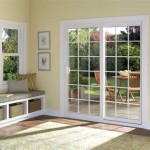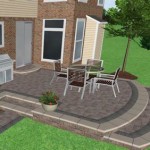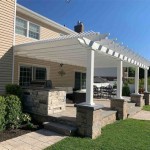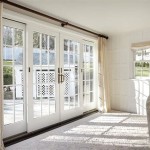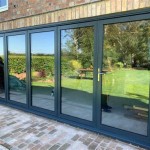Patio Door with Screen and Glass: Functionality and Design
Patio doors serve as a crucial transition between indoor and outdoor living spaces. They provide natural light, ventilation, and easy access to patios, decks, and backyards. Patio doors equipped with both screens and glass panels offer a versatile solution, enabling homeowners to enjoy the benefits of both unobstructed views and protection from insects and the elements.
The design and functionality of patio doors with screens and glass have evolved considerably, incorporating advanced materials, improved energy efficiency, and enhanced security features. Choosing the right patio door requires careful consideration of factors such as the door’s configuration, glazing options, frame material, and screen type. The following sections will explore these aspects in detail.
Configurations of Patio Doors with Screens and Glass
Patio doors with screens and glass come in several configurations, each offering distinct advantages in terms of space utilization, accessibility, and aesthetic appeal.
Sliding Patio Doors: Sliding patio doors, also known as gliding doors, operate by sliding horizontally along a track. They consist of at least two panels, one of which slides open while the other remains stationary. A screen is typically positioned on the exterior side of the sliding panel, allowing ventilation when the door is open without allowing insects inside. Sliding doors are a space-saving choice, making them suitable for rooms where a swinging door would obstruct furniture placement or traffic flow. They are a common choice for many homeowners, providing a seamless transition to the outdoors.
Hinged Patio Doors: Also known as French doors, hinged patio doors swing open on hinges, similar to traditional doors. They can be configured as single doors or double doors, with both panels opening outward or inward. In order to incorporate a screen, hinged patio doors usually require a separate screen door that swings independently. Retractable screen systems offer another solution, allowing the screen to be pulled across the door opening when needed and retracted into a housing when not in use. French doors are often preferred for their classic aesthetic and wider opening, offering unobstructed access and ventilation. They complement traditional architectural styles well.
Folding Patio Doors: Folding patio doors, also known as bi-fold doors, consist of multiple panels that fold together like an accordion. When fully opened, they create a wide, unobstructed opening, seamlessly connecting indoor and outdoor spaces. Screens for folding patio doors typically consist of a retractable system that spans the entire opening, providing insect protection while maintaining the open-air feel. Folding doors are ideal for creating expansive openings and maximizing natural light and ventilation. They are a premium choice for those seeking a dramatic architectural feature and maximized indoor-outdoor flow.
Outswing Patio Doors: Outswing patio doors are much like traditional hinged doors, but they swing outwards. This can be advantageous in certain situations, such as maximizing interior space or allowing better use of a patio area immediately outside the door. Similar to inswing hinged doors, they can utilize a separate swinging screen door or a retractable screen system.
Besides these standard configurations, custom designs and variations exist. The selection of the appropriate configuration depends largely on the size of the opening, the architectural style of the home, and the desired functionality.
Glass Options for Patio Doors
The type of glass used in a patio door significantly impacts its energy efficiency, security, and overall performance. Several glass options are available, including:
Single-Pane Glass: Single-pane glass is the least expensive option but offers minimal insulation. It is generally not recommended for patio doors due to its poor energy efficiency and lack of security. Single-pane glass allows significant heat transfer, leading to higher energy bills and reduced comfort.
Double-Pane Glass: Double-pane glass consists of two panes of glass separated by a spacer and filled with air or an inert gas, such as argon or krypton. This provides significantly better insulation than single-pane glass, reducing heat transfer and improving energy efficiency. Double-pane glass is a common and cost-effective choice for patio doors, offering a good balance of energy efficiency and affordability.
Triple-Pane Glass: Triple-pane glass consists of three panes of glass with two spacers and two gas fills. It offers the highest level of insulation, significantly reducing heat transfer and improving energy efficiency. Triple-pane glass is particularly beneficial in regions with extreme temperatures and can result in substantial energy savings over time. It also offers improved sound insulation, making it a good option for homes in noisy environments.
Low-E Glass: Low-E (low-emissivity) glass is coated with a thin, transparent coating that reflects infrared radiation, reducing heat transfer. It helps keep homes cooler in the summer by blocking solar heat gain and warmer in the winter by preventing heat from escaping. Low-E coatings can be applied to single-pane, double-pane, or triple-pane glass, further enhancing their energy efficiency. Different types of Low-E coatings are available, each designed for specific climates and performance requirements.
Tempered Glass: Tempered glass is a type of safety glass that is heat-treated to make it much stronger than standard glass. If broken, it shatters into small, blunt fragments instead of sharp shards, reducing the risk of injury. Tempered glass is often required by building codes for patio doors, particularly in areas where breakage is more likely, such as near walkways or stairs. The safety aspect is a primary reason for its selection.
Laminated Glass: Laminated glass consists of two or more layers of glass bonded together with a layer of plastic interlayer. It is highly resistant to breakage and provides enhanced security, as the interlayer holds the glass fragments in place even if the glass is shattered. Laminated glass also offers improved sound insulation and can block UV rays, protecting furniture and flooring from fading. It provides a higher level of security compared to traditional tempered glass.
The choice of glass depends on factors such as budget, energy efficiency goals, security concerns, and aesthetic preferences. It is imperative to consider the long-term benefits of investing in higher-performing glass options, such as lower energy bills and increased home value.
Frame Materials for Patio Doors
The frame material of a patio door influences its durability, energy efficiency, maintenance requirements, and aesthetic appeal. Common frame materials include:
Vinyl: Vinyl is a popular choice for patio door frames due to its affordability, low maintenance requirements, and energy efficiency. Vinyl frames are resistant to rot, corrosion, and insect damage and require minimal upkeep. They also offer good insulation, reducing heat transfer and improving energy efficiency. Vinyl frames are available in a variety of colors and styles, and can often be painted to match the aesthetic of the home. However, vinyl frames may not be as strong or durable as other materials, such as wood or aluminum, and can be prone to fading or warping over time.
Wood: Wood frames offer a classic, elegant look and provide excellent insulation. Wood is a natural insulator, helping to keep homes warmer in the winter and cooler in the summer. Wood frames can be painted or stained to match any décor and are available in a variety of wood species, each with its own unique grain pattern and characteristics. However, wood frames require regular maintenance, such as painting or staining, to protect them from rot, moisture damage, and insect infestation. Wood frames are also generally more expensive than vinyl or aluminum frames.
Aluminum: Aluminum frames are strong, durable, and lightweight, making them a good choice for large patio doors. Aluminum frames are resistant to corrosion and require minimal maintenance. They can be easily painted or powder-coated in a variety of colors. However, aluminum frames are not as energy-efficient as vinyl or wood frames, as they conduct heat more readily. Thermal breaks can be incorporated into aluminum frames to improve their insulation properties. These breaks are often made of a less conductive material that separates the interior and exterior sections of the frame.
Fiberglass: Fiberglass frames combine the strength and durability of aluminum with the energy efficiency of wood. Fiberglass is resistant to rot, corrosion, and insect damage, and requires minimal maintenance. It also offers excellent insulation and is dimensionally stable, meaning it does not expand or contract with temperature changes. Fiberglass frames are available in a variety of colors and styles and can be painted or stained. They are a premium choice for homeowners seeking a high-performance, low-maintenance patio door frame.
Composite: Composite frames are made from a mixture of wood fibers and plastic. They offer a combination of durability, energy efficiency, and low maintenance. Composite frames are resistant to rot, corrosion, and insect damage, and require minimal upkeep. They are also available in a variety of colors and styles and can be painted or stained. Composite frames provide a good middle-ground option for those seeking a balance of benefits.
The selection of the frame material should consider the climate, architectural style, budget, and desired level of maintenance. Evaluating the long-term performance and cost-effectiveness of each material is essential for making an informed decision.

Before And After Sliding Door With Retractable Screen Pella

Before And After Sliding Door With Retractable Screen Pella

Custom Sliding Screen Doors Replacements Screenmobile

Retractable Accordion Screen Patio Door Ag Millworks

Weather Star 80 In Brisa White Retractable Screen Door For Sliding 77030351 The Home

Sliding Patio Screen Doors Sacramento Ca A To Z Window Screens

Pin By Rebecca Gebbers On Dream Home French Doors With Screens Patio Exterior

21 Fresh Ways To Incorporate Barn Doors Into Your Home Sliding Screen Rustic Patio Glass

Screens For Wood Patio Doors Pella

5 Reasons You Need A Screen Door Sacramento Ca To Z Window



